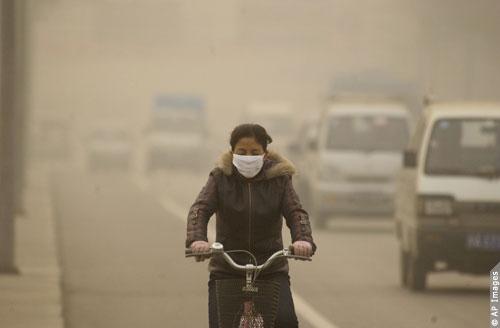New research discovers vast impact on lifespan from China’s pollution
Air pollution has taken a toll on the health of Chinese residents. A person living north of the Huai River can expect to lives five years less than a person south of the river, an unintended legacy of the government’s policy to give free coal for winter h
Highly polluted air is bad for your health — and that’s particularly true when it’s air full of small particles from coal-fired power plants, as studies going back for years have shown.
But just how bad? For the first time, there’s a study that actually quantifies how many years of life expectancy are lost based on a given amount of particulate exposure.
Michael Greenstone, a professor of environmental economics at MIT, recently published a paper that compared two populations in China that experienced very different levels of polluted air. Greenstone’s research is based on a Chinese policy in effect from the 1950s to the 1980s. In that time period, people who lived north of China’s Huai River were given free heating and the pollution that went with the coal-powered infrastructure that went with it.
South of the Huai River, though, there was no be no heating, a vestige of China’s poverty in that time period. People were even forbidden from building heating facilities — which left them cold, no doubt, but pollution-free.
A perfect way for Greenstone to get data on two similar, but separate, groups of people.
“What we find is pretty dramatic,” he said.
Greenstone gathered data from 1981 to 2000. Living north of the river led to almost 200 micrograms per cubic meter increase in total systemic particulates, he said.
Put in context, pollution levels were about 350 micrograms per cubic meter in the south, and 550 micrograms per cubic meter in the north, compared to the U.S. now of about 40 or 50 micrograms per cubic meter.
The results were just as stark.
“At the river’s edge there’s a jump up in particulates concentrations, and that’s matched by a jump down in life expectancy,” he said. “People who live north of the Huai River, and were the intended beneficiaries of these policies, have life expectancy about 5.5 years less than people who live to the south.”
Some 500 million people live in China north of the Huai River — a number that Greenstone translates into 2.5 billion lost years of life.
“The effects appear to be coming from elevated mortality rates due to cardiorespiratory causes of disease that are plausibly related to air pollution,” he said.
Ailments like lung cancer and heart attacks, for example, are more prevalent north of the Huai, whereas illnesses not possibly linked to air pollution show no dramatic divide along the same line.
“What we find is that an extra hundred micrograms per cubic meter of total suspended particulates is associated with a loss of life expectancy of about three years,” Greenstone said. “That can be applied to other settings, both in other countries, and in other parts of China as well.”
To this day, the Chinese government continues to subsidize heating in northern China, while not doing so in the south. For example, in Chengdu, south of the river but far enough north that winters are cold, it’s not uncommon for public buildings to go without heat. Greenstone said he taught classes at a university there and regularly had classes with students wearing winter coats.
The study has already generated widespread attention in China as well. Two of Greenstone’s co-authors are Chinese, and Greenstone said they reported wide pickup on microblogs.
This new research, he added, gives China a chance to vastly improve the health — and lifespan — of its citizens.
“I think what this study has helped to highlight is that consequences of air pollution in terms of human health are greater than what had been previously realized,” he said.
